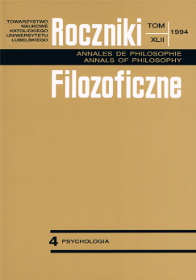Ought Self in Authoritarian Adolescents. Selected Problem s
Abstract
This paper starts with a brief account of the self-system. First the structure of self-concept is investigated. Three main dimensions are underlined: cognitive, evaluative and normative. Within the normative dimension i.e. self-ideal two major components are distinguished: ought self and ideal self. The former is someone’s sense of duties and obligations, while the latter refers to an individual’s wishes, hopes and desires. Then, the main approaches in the studies of authoritarianism are described and an attempt is made to show their common features. Consequently, it is stressed that, especially in adolescents, there seems to exist a very close relationship between authoritarian personality characteristics and the content and formal structure of self-ideal. Ought self at this life phase should contain unique attributes.
Data from 95 adolescents (4th year of secondary school; Males-43; Females-52) were analyzed. Gough et al’s (1980) Adjective Check List was applied as a measure of ought and ideal selves. Subjects were divided into 3 groups according to different levels of authoritarianism measured by Webster et al’s (1955) ’New F scale’.
The extreme groups: high-authoritarian (A) and low-authoritarian (n A) differed at a statistically significant level. Ought selves of A and n A groups varied only in terms of magnitude without qualitative differences. A very few differences between Ideal and Ought selves were found within group A.
The major result of the study was that two distinct sets of correlates were found between F scale scores and self- characteristics. Within group A, subjects tend to be more passive, defensive, regressive and submissive. On the other side, individuals in group n A seem to be more dominant, caring, with positive self-regard with the increase of their F scale score.
Copyright (c) 1994 Roczniki Filozoficzne

This work is licensed under a Creative Commons Attribution-NonCommercial-NoDerivatives 4.0 International License.





